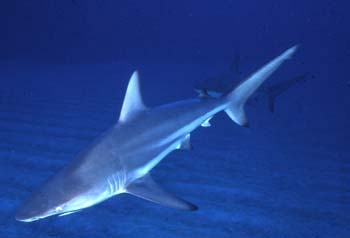
|
|
|
|
|
|
Shark Info (06-15-2001) |
Author |
|
Intro: |
Shark Info |
|
Main article: |
Shark Info |
|
Article 1: |
Fishing, fins and the lack of sufficient international controls |
Shark Info |
Article 2: |
Shark Info |
|
Article 3: |
Dr. E. K. Ritter |
|
Fact Sheet: |
Dr. E. K. Ritter |
|
Series of shark accidents in Florida: Facts and backgroundMid-April in Florida: Within the space of one week seven people were bitten by sharks - a report which was quickly picked up by the news media in all of the U.S. as well as various European countries. None of the bites were serious, they were simply scratches, still it was considered reason enough to precisely reexamine domestic and foreign accident statistics. In Australia two people were also bitten by sharks.
From an international point of view, Florida registers the most
accidents. Since 1916 the relevant Institute GSAF (Global Shark Attack
File) and the ISAF (International Shark Attack File) recorded 439 cases,
29 of which were fatal. California holds rank two in the number of
accidents, but has about four times less accidents than Florida and only
ten fatal accidents. The question thus arises as to why considerably
more accidents occur in Florida compared to other places.
Florida's geographical position and shape are unique. Stretching for a
distance of more than six degrees latitude, it separates two oceans and
its continental tip reaches into the Caribbean Sea, while the Gulf
Stream flows to the north off its eastern coast.
These accidents can be attributed to large-sized sharks such as bull sharks (Carcharhinus Ieucas) and tiger sharks (Galeocerdo cuvier). The latest fatal encounter with a bull shark occurred in the year 2000 in St. Petersburg, whereby in this case one cannot speak of it as being a real attack. The victim had noticed a large swarm of excited fish and then sprang into the very murky water to observe them more closely. What then happened is currently being more closely investigated by the GSAF (Global Shark Attack File). In most cases it is a string of unfortunate circumstances which lead to an accident. Unfortunately this is always played down or even ignored in reports on shark accidents. It should thus come as no surprise that none of the reports over the past weeks delved into the behavior of blacktip sharks or to last year's incident with the bull sharks in St. Petersburg. On the contrary, reports emphasized the fact that in the year 2000 the number of accidents reached the absolute record of 79, 10 of which were fatal. Another subject presented in all the newspapers was the increase of shark accidents over the past 10 years. Nonetheless, if one looks at the number of increasing people who go swimming each year another tendency can be recognized: namely, a reduction in accident frequency, a fact which does not sell newspapers. * Dr. Erich K. Ritter is a shark biologist, senior scientist of the Green Marine Institutes and assistant professor at Hofstra University, New York. May be published only by indicating the source: Shark Info / Dr. E. K. Ritter |
|
|
|
|
|
|||||

